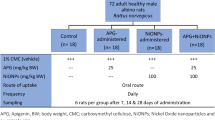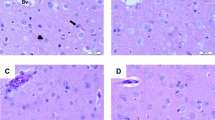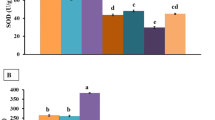Abstract
The relationship between Ni-induced hepatic lipid peroxidation (LPO) and the concentrations of Ni and trace elements was investigated in male ICR mice. The protective effects of antioxidants were also examined. Hepatic LPO and the concentrations of Ni, Fe, Cu, and Zn in the liver were enhanced after an ip injection of nickel chloride (NiCl2). Dose-response studies were conducted on male mice with different groups being injected with 50, 85, and 170 μmol Ni/kg. LPO increased significantly in a dose-dependent manner. In time-course studies, mice were administrated NiCl2 (170 μmol Ni/kg) and killed at intervals of 6, 12, 24, and 48 h after injection. Both LPO and the accumulation of Ni, Fe, Cu, and Zn in the liver showed a significantly positive time-course relationship after NiCl2 injection. At 1 h and 24 h after a single ip injection of 170 μmol Ni/kg, the mice were given an ip injection of ascorbic acid (vit C), glutathione (GSH), and selenium (Se). Vit C and GSH significantly decreased both the level of hepatic LPO and the concentration of Ni in the liver, but did not decrease the accumulation of Fe, Cu, and Zn. However, LPO in the experimental group of mice was different significantly from that in the control group. In conclusion, the results suggest that Ni-induced hepatic LPO may result from increasing the amounts of Ni, Fe, and Cu, since these elements are involved in the generation of hydroxyl radical by inducing the Fenton reaction, thus instigating the Ni-mediated hepatic LPO. The protective effects of vit C and GSH in hepatic LPO result not only from removing the oxygen reactive species, but also from decreasing the Ni concentration.
Similar content being viewed by others
References
F. W. Sunderman, Jr., B. Dingle, S. M. Hopfer, and T. Swift, Acute nickel toxicity in electroplating workers who accidentally ingested a solution of nickel sulfate and nickel chloride,Amer. J. Ind. Med. 14, 257–266 (1988a).
T. P. Coogan, D. M. Latta, E. T. Snow, and M. Costa, Toxicity and carcinogenicity of nickel compounds,CRC Crit. Rev. Toxicol. 19, 341–384 (1989).
F. W. Sunderman, Jr., Mechanisms of nickel carcinogenesis,J. Work Environ. Health 15, 1–12 (1989).
E. Donskoy, M. Donskoy, F. Forouhar, C. G. Gillies, A. Marzouk, M. C. Reid, O. Zaharia, and F. W. Sunderman, Jr., Hepatic toxicity of nickel chloride in rats,Ann. Clin. Lab. Sci. 16, 108–117 (1986).
F. W. Sunderman, Jr., A. Marzouk, S. M. Hopfer, O. Zaharia, and M. C. Reid, Increased lipid peroxidation in tissue of nickel chloride treared rats,Ann. Clin. Lab. Sci. 15, 229–236 (1985).
H. R. Andersen and O. Andersen, Effect of nickel chloride on hepatic lipid peroxidation and glutathione concentration in mice,Biol. Trace Elem. Res. 21, 255–261 (1989).
K. S. Kasprzak and R. M. Bare, In vitro polymerization of histones by carcinogenic nickel compound,Carcinogenesis 10, 621–624 (1989).
B. Halliwell and J. M. C. Gutteridge, Oxygen toxicity, oxygen radicals, transition metals and disease,Biochem. J. 219, 1–14 (1984).
M. Younes and C. P. Siegers, Interrelation between lipid peroxidation and other hepatotoxic events,Biochem. Pharmacol. 33, 2001–2003 (1984).
B. Halliwell, Free radicals and antioxidants: personal view,Nutr. Rev. 52, 253–265 (1994).
J. M. C. Cutteridge, Lipid peroxidation and antioxidant as biomarkers of tissue damage,Clin. Chem. 41, 1819–1825 (1995).
B. Frei, R. Stocker, and B. N. Ames, Antioxidant defenses and lipid peroxidation in human blood plasma,Proc. Natl. Acad. Sci. USA 85, 9748–9752 (1988).
K. L. Retsky and B. Frei, Vitamin C prevents metal ion-dependent initiation and propagation of lipid peroxidation in human low-density lipoprotein,Biochim. Biophys. Acta. 1257, 279–287 (1995).
B. Chance, H. Sies, and A. Boxeris, Hydroperoxide metablism in mammalian organs,Physiol. Rev. 59, 527–605 (1979).
S. V. S. Rana and S. Verma, Protective effects of GSH, vitamin E and selenium on lipid peroxidation in cadmium-fed rats,Biol. Trace. Element Res. 51, 161–168 (1996).
M. M. Ricetti, G. C. Guid, G. Bellisola, R. Marrocchella, A. Rigo, and G. Perona, Selemium enhances glutathione peroxidase activity and prostacyclin relase in cultured human endothelia cell,Biol. Trace Element Res. 46, 113–123 (1994).
S. V. S. Rana and P. R. Boorn, Antiperoxidative mechanism offered selenium against liver injury caused by cadmium and mercury in rats,Bull. Environ. Contam. Toxicol. 42, 120–124 (1992).
S. Kanno, Y. Aoki, J. S. Suzuki, N. Takeichi, S. Misawa, and K. T. Suzuki, Enhanced synthesis of metallothionein as a possible cause of abnormal copper accumulation in LEC rats,J. Inorg. Biochem. 56, 117–125 (1994).
J. Torreilles and M. C. Guerin, Nickel(II) as a temporary catalyst for hydroxyl radical generation,FEBS Lett. 272, 58–60 (1990).
World Health Organization], Nickel Environmemtal Health Criteria,108 (1991).
N. A. Kostromina and V. P. Tikhonov, NMR study of nickel complexation with L-histidine,Theor. Exp. Chem. 16, 511–518 (1980).
K. S. Kasprzak, The role of oxidative damage in metal carinogenicity,Chem. Res. Toxicol. 4, 604–615 (1991).
M. Levine, New concepts in the biology and biochemistry of ascobric acid,N Engl. J. Med. 314, 892–902 (1986).
E. N. Frankel and W. E. Neff, Formation of malonaldehyde from lipid oxidation products,J. Exper. Biol. 21, 343–346 (1983).
D. D. Perrin and A. E. Wutt, Complex formation of zinc and cadmium with glutathione,Biochem. Biophys. Acta. 230, 96–104 (1971).
S. J. Stohs and D. Bagchi, Oxidative mechanisms in the toxicity of metal ions,Free Radical Med. 8, 321–336 (1995).
M. Mirsa, R. Z. Rodriguez, and K. S. Kasprzak, Nickel induced lipid peroxidation in the rat: Correlation with nickel effect on antioxidant defense,Toxicology 64, 1–17 (1990).
P. C. Chan, O. G. Peller, and L. Kesner, Copper(II)-catalyzed lipid peroxidation in liposomes and erythrocyte membrane,Lipid 17, 331–337 (1982).
M. Athar, K. Syed, S. K. Hasan, and R. C. Srivastava, Evidence for the involement of hydroxyl radicals in nickel mediated enhancement of lipid peroxidation: implications for nickel carcinogenesis,Biochem. Biophys. Res. Commun. 147, 1276–1281 (1987).
F. W. Sunderman, Jr., M. C. Reid, L. M. Bibeau, and J. V. Linden, Nickel induction of microsomal heme oxygenase activity in rodents,Toxicol. Appl. Pharmacol. 68, 87–95 (1983).
S. I. Rapaport,Introduction to Hematology, J. B. Lippincott, Philadelphia, pp. 39–40 (1987).
J. A. Imlay, S. M. Chin, and S. Linn, Toxic DNA damage by hydrogen peroxide through the Fenton reaction in vivo and vitro,Science 240, 640–642 (1988).
M. Chvapil, Effects of zinc on cells and biomembranes,Med. Clin. North Am. 60, 799–812 (1972).
I. Fridovich, Superoxide dismutases: Regularities and irregularities,Harvey Lect. 79, 51–75 (1985).
I. Fridovich, Superoxide dismutases. Anadaptation to a paramagnetic gas,J. Biol. Chem. 264, 7761–7764 (1989).
R. E. Rodrigue, M. Misra, S. L. North, and K. S. Kasprzak, Nickel-induced lipid peroxidation in the liver of different strains of mice and its relation to nickel effects on antioxidant systems,Toxicol. Lett. 57, 269–281 (1991).
H. R. Warner, Super dismutase, aging and degenerative disease,Free Radical Biol. Med. 17, 249–258 (1994).
T. Yamada, T. Agui, Y. Suzuki, M. Sato, and K. Matsumoto, Inhibition of the copper incorporation into ceruloplasmin leads to the deficiency in serum ceruloplasmin activity in Long-Evans Cinnamon mutant rat,J. Biol. Chem. 268, 8965–8971 (1993).
J. Koropatonick and M. G. Cherian, A mutant mouse (tx) with increased hepatic metallothionein stability and accumulation,Biochem. J. 296, 443–449 (1994).
M. A. Dunn, T. L. Blalock, and R. J. Cousins, Metallothionein,Proc. Soc. Exp. Biol. Med. 185, 107–119 (1987).
Author information
Authors and Affiliations
Rights and permissions
About this article
Cite this article
Chen, CY., Huang, YL. & Lin, TH. lipid peroxidation in liver of mice administrated with nickel chloride. Biol Trace Elem Res 61, 193–205 (1998). https://doi.org/10.1007/BF02784030
Received:
Revised:
Accepted:
Issue Date:
DOI: https://doi.org/10.1007/BF02784030




